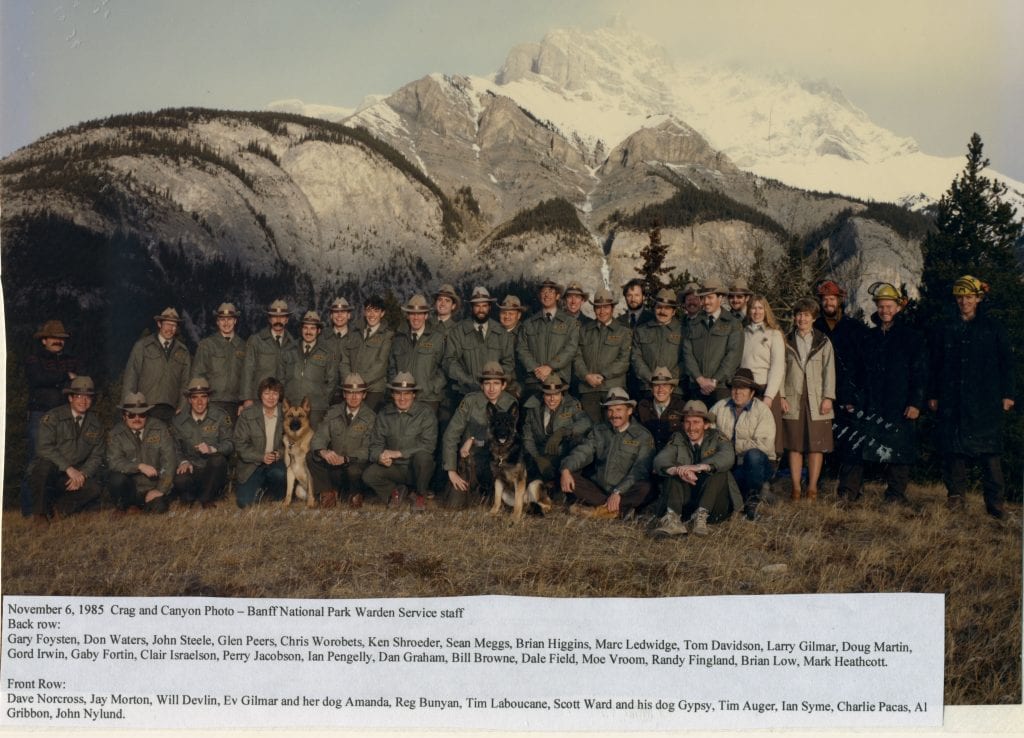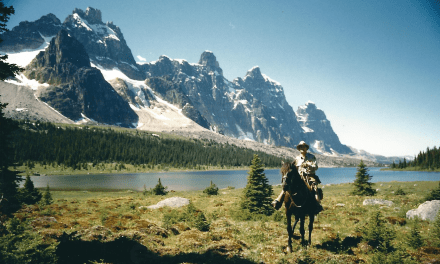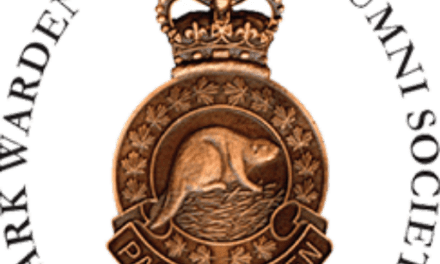MD: Where did they come from?
Tom: I think they were the gang from Red Deer – I forget what they were called now. And that was mid 70’s.
MD: How many of them?
Tom: There were about 20 or so. The RCMP escorted them through the park and west into BC.
MD: How did the Warden Service change over the years?
Tom: For me, I guess …during my era, was way after centralization and so on. I think the specialization where each section became a little more specialized, at least in the bigger parks and wardens were less and less able to get involved with all different aspects of the job. And then at the same time, the fight for handguns happened, and that really took its toll on how the warden service was structured as well. I think that happened into the 2000’s and past there. So the results of that really changed how the warden service operated and was structured as well.
MD: What about the warden service was important to you?
Tom: I think most of the wardens were conservationists, and had a pretty strong feeling for the ecosystem, and park protection. And that was something that was a pretty strong driver for us. And it wasn’t just the backcountry, it was all the facilities and structures and visitation and all those things that affect it. Teamwork, and the camaraderie, and I think what helped with the camaraderie was, in a big way really, was all the public safety training/program, because a lot of the schools weren’t easy schools, and it really brought us together, and also the rescues really created quite a strong team – everyone with different strengths, but when you put it all together, it was a pretty strong outfit.
MD: Are there any legends or stories associated with the warden service, or anyone from the service that stands out in your mind?
Tom: Well, I guess an early Chief Warden – in Waterton I worked for Max Winkler, he was a pretty strong personality and pretty dedicated – probably one of the most dedicated parks employees that I knew. If you were on a night shift, in the middle of the night, and something started happening, he was on the (radio)? It was like all the time – he never took a day off.
MD: Is he still alive?
Tom: He passed away last fall – September a year ago. He spent quite a bit of time in Jasper. He was difficult to work for – he was a good guy. I just worked for him as a seasonal, so learning everything. Max certainly stood out. for me, because of the Public Safety, Peter Fuhrmann and Willi Pfisterer really stood out as well. They were mountain guides hired as Alpine Specialists to design and improve the whole public safety mountain rescue program. When I was in Jasper, I learned as much as I could from Willi and also got on quite a few schools with Peter Fuhrmann as well. Peter and Willi – were good individuals as far as teaching you to be organized. If you weren’t, you heard about it! Peter lives in Harvie Heights, and still looks almost the same as when he retired.
MD: Is there anything about the warden service, as you knew it, that you would want future generations to know?
Tom: Well, I think just how, in the old days, how you used to be involved with many aspects of the job, whereas now it has changed and is more specialized. But I think even though the job has changed somewhat, and it changes with different priorities and so on, I think the goal remains the same, which is protecting the land and the ecosystem and the future of the park for future generations. So the end result and the job is really the same as far as a goal in my view. I guess new folks starting now – they don’t know how it used to be, so it’s what it is now. There are some things we lost, like we don’t seem to be in the backcountry much, patrolling that and things are done differently.
MD: What made the warden service such a unique organization?
Tom: I don’t know how unique it was, but I think…’cause I did some work afterwards for Provincial Parks, and they were structured…their job, as far as the CO’s were the same as ours – in fact they structured themselves after us, and it’s a very similar job with many aspects of the job, and it takes teamwork to get it done. And I’ve had some affiliation with the US National Parks, and it’s similar there also. So I think very similar jobs, and in that sense, it’s not unique. It’s unique, but that job, probably anywhere, is a similar job.
MD: Any lasting memories as a warden?
Tom: Well, I had many good memories – a lot of good climbing trips and backcountry horse trips, lots of sunrises and sunsets, and lots of close friends because of it – people that you trusted your life with. Some of Willi’s trips – I remember one where we were climbing Mt. Messner in Jasper, which is a long fairly narrow ridge, and he had a saying for everything, but most of the wardens were clinging on to the rock, and he’s puffing on his pipe, and he says “Stand up – you won’t bump your head!” He was Austrian. And he did a few things before he actually got on with Parks – he did some work in BC, and then he actually was involved with the avalanche program in Rogers Pass before he got the Alpine Specialist position. He did a bunch of guiding.
MD: Do you ever miss being a Warden?
Tom: Well, I guess I don’t have the same opportunities, but I’m out doing similar things all the time. I don’t know that I could put up with the bureaucracy anymore, I had my run at it and I had chosen to stay in the field for the most part, so for me, I didn’t want to get stuck behind a desk. But in some respects, you’re better to get behind the desk and get up there a bit, and get a better pension out of it.
MD: Do you have any photos of yourself as a warden that we might be able to use?
Tom: I don’t have much of me, really. I’ll have to have a look and see what I have. There might be either from parades or backcountry, or climbing trips. I took a lot of pictures but if your taking them your not in very many.
MD: What year did you retire?
Tom: In spring 2007, and actually I’ve worked each summer since. I went right into Kananaskis Country doing bear work there, and I’ve been doing bear work each summer since, initially with Jay Honeyman with the Aversive Conditioning program for the grizzly bears in Kananaskis. There was a contract for that project – money for that every year, and then as soon as the new government came in, they cut the project, ‘cause there hadn’t been any bear problems. That’s because of the work we did! That program isn’t (running anymore), but they scratched together enough money for two guys part of the summer to help with bears. But it was so busy with bears we had (had) 6 people on the project plus bear dogs, and these two now are just two extra people to help mostly through the berry season. When they used to have 6 -10 bear calls at any one time in different locations – bear in the campground here, and bear jams on the highway…
All the facilities in Kananaskis are right along the lake, it’s the bears’ travel route also, so that’s how it all worked out. When you build a facility like a campground, they clear the site, and then by the time they rehab with a grass and clover mixture, that attracts the bears also. Because of opening up the forest canopy buffalo berry was very prevalent in each campground, so that had to be all cut out, which gives you about 5 years before it starts producing berries again.
MD: Will you do that again this summer?
Tom: I do some different work – it’s for the company that does most of the bear work around Fort McMurray. And it’s mostly related to the oil patch, where they attract quite a few bears. When they initially started up, they didn’t have facilities bear-proofed, so they habituated quite a few bears because of garbage. They have facilities all cleaned up now. About 8 years ago, there was a lady killed by a habituated bear on one of the sites, and so the fellow I contract to, the company name is Bear Scare. He happened to be doing bear courses up there at the time, and was almost right there. So he went over and helped assess the site, and so on. And it was an older black bear that was pretty habituated. No one had bear spray on site. The woman went from one building going across the parking lot area to another, she saw the bear and she (the lady) laid down and played dead, and it came right up – it trotted right over to her and started chewing on her. By the time they got the bear off, there was so much damage, she didn’t survive. She was with another group, so she was going towards the other group, but the other group didn’t know what to do. The group blew horns and eventually managed to chase the bear off.
MD: For some reason, people have that planted in their heads, to play dead.
Tom: Yes, it’s from a long time ago, to play dead.
MD: And you were up north doing a bit of work too, weren’t you?
Tom: Yes, I’ve only been at Fort McMurray once, and it was on a pipeline – with a crew, and pushing bears away if they came close to us. And actually with all the pipelines and facilities, they’ve done there, they’ve actually increased the bear habitat big-time. All the pipelines – the forest right beside is old-growth, really gnarly forest – it could hardly support a squirrel, and so now all these pipelines that are grass and clover – they’re travel paths for the bears, so they’ve really increased the bear habitat. And it’s not something that they talk about, or maybe even realize.
Most of my work has been up on North Warning System Sites. They have had numerous incidents with polar bears over the years. Their policy is that they if have a crew working outside, they require a bear guy. And that’s all you do – if you see a bear coming, get everyone in somewhere safe. You’re out there with a shotgun, banger pistol and scanning for bears. It’s pretty boring until a bear shows up!
MD: So you’ve seen a bit of the north that way then.
Tom: Yeah… a few spots that you couldn’t get into otherwise, ‘cause it’s all hush-hush, and it would cost you a fortune even if you could. Of course, Pangnirtung and many of the major villages you can fly to commercially, but to the North Warning Sites would be private sites and you would need a permit to even land there.
MD: So you go in by helicopter?
Tom: Yes, you go to the closest settlement via commercial flights and then by private flights either fixed wing or large helicopter. But you get weathered in there – some of the crews go in for a week, but then the weather socks in and they’re spending another week waiting trying to get out.
MD: And you still do some climbing? I see you over at Elevation Place?
Tom: Yeah…a little bit, trying to keep in shape, but the kids climb circles around me.
MD: Is there anything I haven’t asked you that you think I should know about the Warden Service?
Tom: No…I’m sure… you’re more up on the recent stuff than I am.
(Brief chat about retirees we still see, current life, etc.)
MD: Is there anyone else I should talk to?
(brief chat about who I’m interviewing)
Tom: Yes, (Gord Peyto) he’d be a good one. He was a dog-handler for years, and then quite a bit of stuff before all that. He’d be excellent – yes. I think Brian (Wallace) might be in Vernon over winter, Dave Carnell, Brian MacDonald. Larry Gilmar.
The Oral History Project continues:
Brian Wallace was interviewed in Phase 8.
Gord Peyto – was interviewed in Phase 8
Dave Carnell is on the list and yet to be interviewed.
Brian Macdonald has been contacted.
Larry Gilmar was interviewed in Phase 3.

1985 Banff Warden Office staff.



